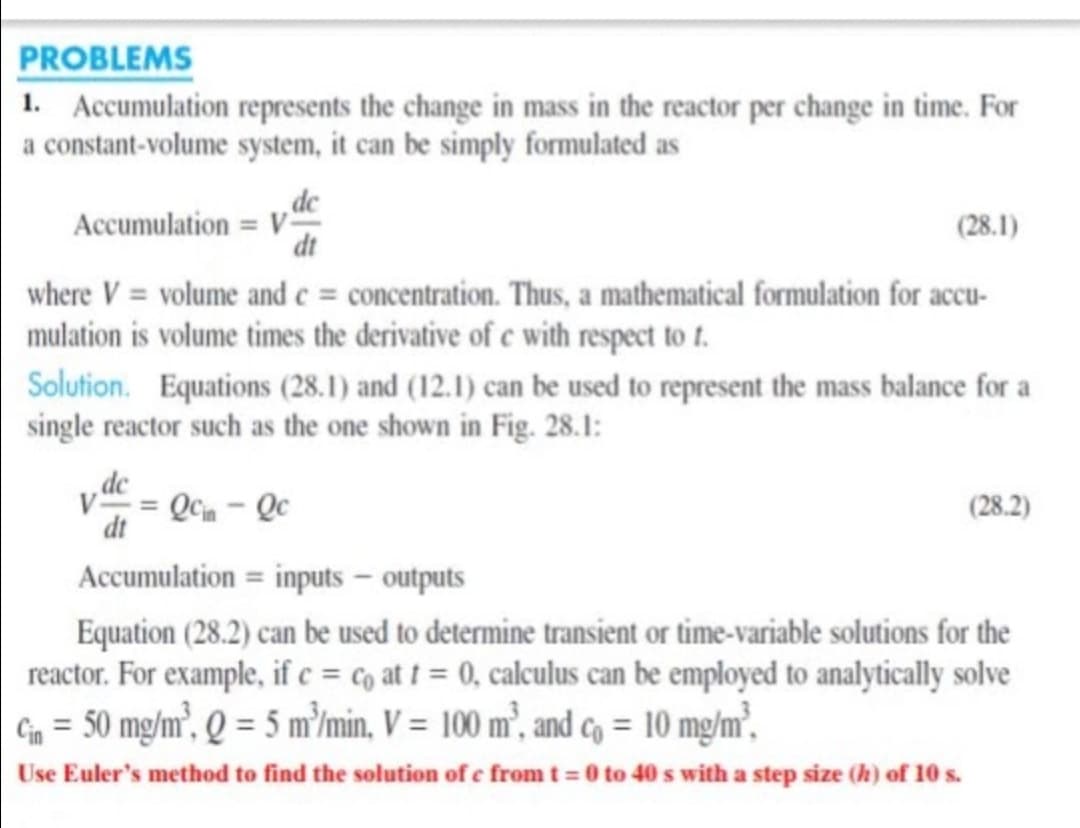PROBLEMS 1. Accumulation represents the change in mass in the reactor per change in time. For a constant-volume system, it can be simply formulated as ,dc Accumulation = V" dt (28.1) where V = volume and e = concentration. Thus, a mathematical formulation for accu- mulation is volume times the derivative of e with respect to t. Solution. Equations (28.1) and (12.1) can be used to represent the mass balance for a single reactor such as the one shown in Fig. 28.1: v de V = Qcin - Qc dt (28.2) Accumulation = inputs – outputs Equation (28.2) can be used to determine transient or time-variable solutions for the reactor. For example, if c = co at t = 0, calculus can be employed to analytically solve Gn = 50 mg/m², Q = 5 m'/min, V = 100 m², and co = 10 mg/m², Use Euler's method to find the solution of e from t= 0 to 40 s with a step size (h) of 10 s.
PROBLEMS 1. Accumulation represents the change in mass in the reactor per change in time. For a constant-volume system, it can be simply formulated as ,dc Accumulation = V" dt (28.1) where V = volume and e = concentration. Thus, a mathematical formulation for accu- mulation is volume times the derivative of e with respect to t. Solution. Equations (28.1) and (12.1) can be used to represent the mass balance for a single reactor such as the one shown in Fig. 28.1: v de V = Qcin - Qc dt (28.2) Accumulation = inputs – outputs Equation (28.2) can be used to determine transient or time-variable solutions for the reactor. For example, if c = co at t = 0, calculus can be employed to analytically solve Gn = 50 mg/m², Q = 5 m'/min, V = 100 m², and co = 10 mg/m², Use Euler's method to find the solution of e from t= 0 to 40 s with a step size (h) of 10 s.
Elements Of Electromagnetics
7th Edition
ISBN:9780190698614
Author:Sadiku, Matthew N. O.
Publisher:Sadiku, Matthew N. O.
ChapterMA: Math Assessment
Section: Chapter Questions
Problem 1.1MA
Related questions
Question

Transcribed Image Text:PROBLEMS
1. Accumulation represents the change in mass in the reactor per change in time. For
a constant-volume system, it can be simply formulated as
,dc
Accumulation = V“
dt
(28.1)
where V = volume and e = concentration. Thus, a mathematical formulation for accu-
mulation is volume times the derivative of e with respect to t.
Solution. Equations (28.1) and (12.1) can be used to represent the mass balance for a
single reactor such as the one shown in Fig. 28.1:
dc
V = Qcm - Qc
(28.2)
dt
Accumulation = inputs – outputs
Equation (28.2) can be used to determine transient or time-variable solutions for the
reactor. For example, if c = co at t = 0, calculus can be employed to analytically solve
G = 50 mg/m², Q = 5 m'/min, V = 100 m²., and co = 10 mg/m²,
Use Euler's method to find the solution of e from t = 0 to 40 s with a step size (h) of 10 s.
Expert Solution
This question has been solved!
Explore an expertly crafted, step-by-step solution for a thorough understanding of key concepts.
Step by step
Solved in 2 steps with 2 images

Knowledge Booster
Learn more about
Need a deep-dive on the concept behind this application? Look no further. Learn more about this topic, mechanical-engineering and related others by exploring similar questions and additional content below.Recommended textbooks for you

Elements Of Electromagnetics
Mechanical Engineering
ISBN:
9780190698614
Author:
Sadiku, Matthew N. O.
Publisher:
Oxford University Press

Mechanics of Materials (10th Edition)
Mechanical Engineering
ISBN:
9780134319650
Author:
Russell C. Hibbeler
Publisher:
PEARSON

Thermodynamics: An Engineering Approach
Mechanical Engineering
ISBN:
9781259822674
Author:
Yunus A. Cengel Dr., Michael A. Boles
Publisher:
McGraw-Hill Education

Elements Of Electromagnetics
Mechanical Engineering
ISBN:
9780190698614
Author:
Sadiku, Matthew N. O.
Publisher:
Oxford University Press

Mechanics of Materials (10th Edition)
Mechanical Engineering
ISBN:
9780134319650
Author:
Russell C. Hibbeler
Publisher:
PEARSON

Thermodynamics: An Engineering Approach
Mechanical Engineering
ISBN:
9781259822674
Author:
Yunus A. Cengel Dr., Michael A. Boles
Publisher:
McGraw-Hill Education

Control Systems Engineering
Mechanical Engineering
ISBN:
9781118170519
Author:
Norman S. Nise
Publisher:
WILEY

Mechanics of Materials (MindTap Course List)
Mechanical Engineering
ISBN:
9781337093347
Author:
Barry J. Goodno, James M. Gere
Publisher:
Cengage Learning

Engineering Mechanics: Statics
Mechanical Engineering
ISBN:
9781118807330
Author:
James L. Meriam, L. G. Kraige, J. N. Bolton
Publisher:
WILEY